sensor TOYOTA IQ 2012 Owners Manual
[x] Cancel search | Manufacturer: TOYOTA, Model Year: 2012, Model line: IQ, Model: TOYOTA IQ 2012Pages: 476, PDF Size: 23.52 MB
Page 40 of 476
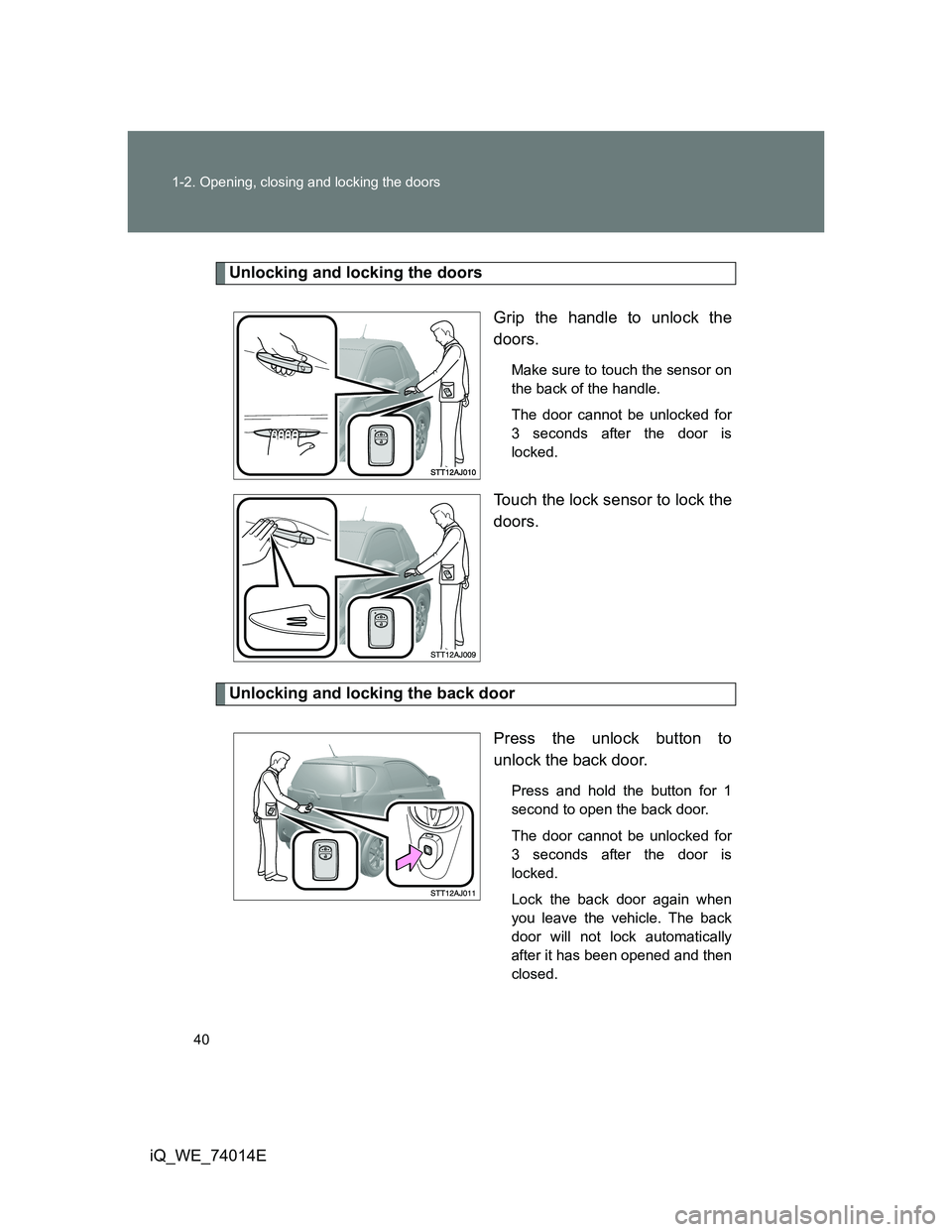
40 1-2. Opening, closing and locking the doors
iQ_WE_74014E
Unlocking and locking the doors
Grip the handle to unlock the
doors.
Make sure to touch the sensor on
the back of the handle.
The door cannot be unlocked for
3 seconds after the door is
locked.
Touch the lock sensor to lock the
doors.
Unlocking and locking the back door
Press the unlock button to
unlock the back door.
Press and hold the button for 1
second to open the back door.
The door cannot be unlocked for
3 seconds after the door is
locked.
Lock the back door again when
you leave the vehicle. The back
door will not lock automatically
after it has been opened and then
closed.
Page 42 of 476
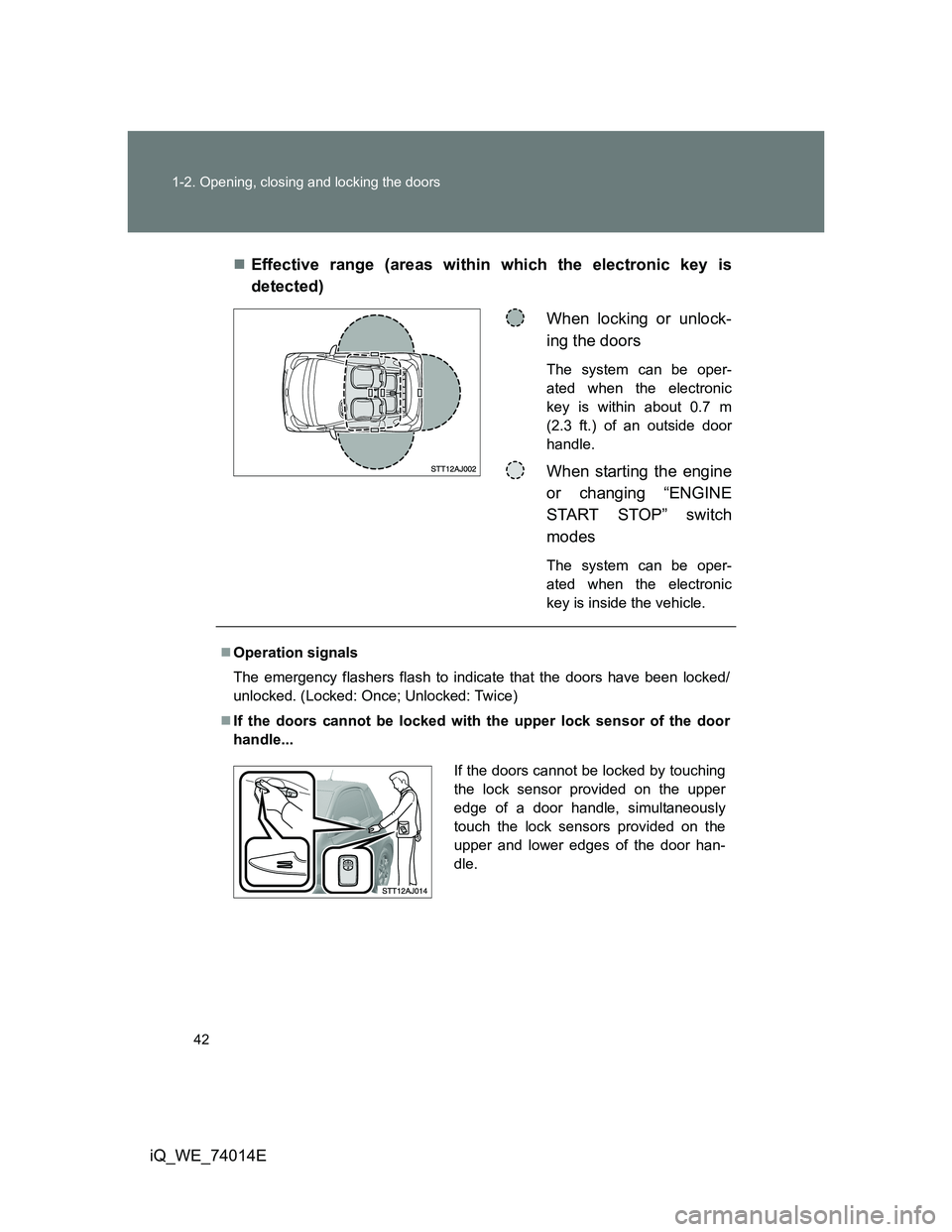
42 1-2. Opening, closing and locking the doors
iQ_WE_74014EEffective range (areas within which the electronic key is
detected)
When locking or unlock-
ing the doors
The system can be oper-
ated when the electronic
key is within about 0.7 m
(2.3 ft.) of an outside door
handle.
When starting the engine
or changing “ENGINE
START STOP” switch
modes
The system can be oper-
ated when the electronic
key is inside the vehicle.
Operation signals
The emergency flashers flash to indicate that the doors have been locked/
unlocked. (Locked: Once; Unlocked: Twice)
If the doors cannot be locked with the upper lock sensor of the door
handle...
If the doors cannot be locked by touching
the lock sensor provided on the upper
edge of a door handle, simultaneously
touch the lock sensors provided on the
upper and lower edges of the door han-
dle.
Page 45 of 476
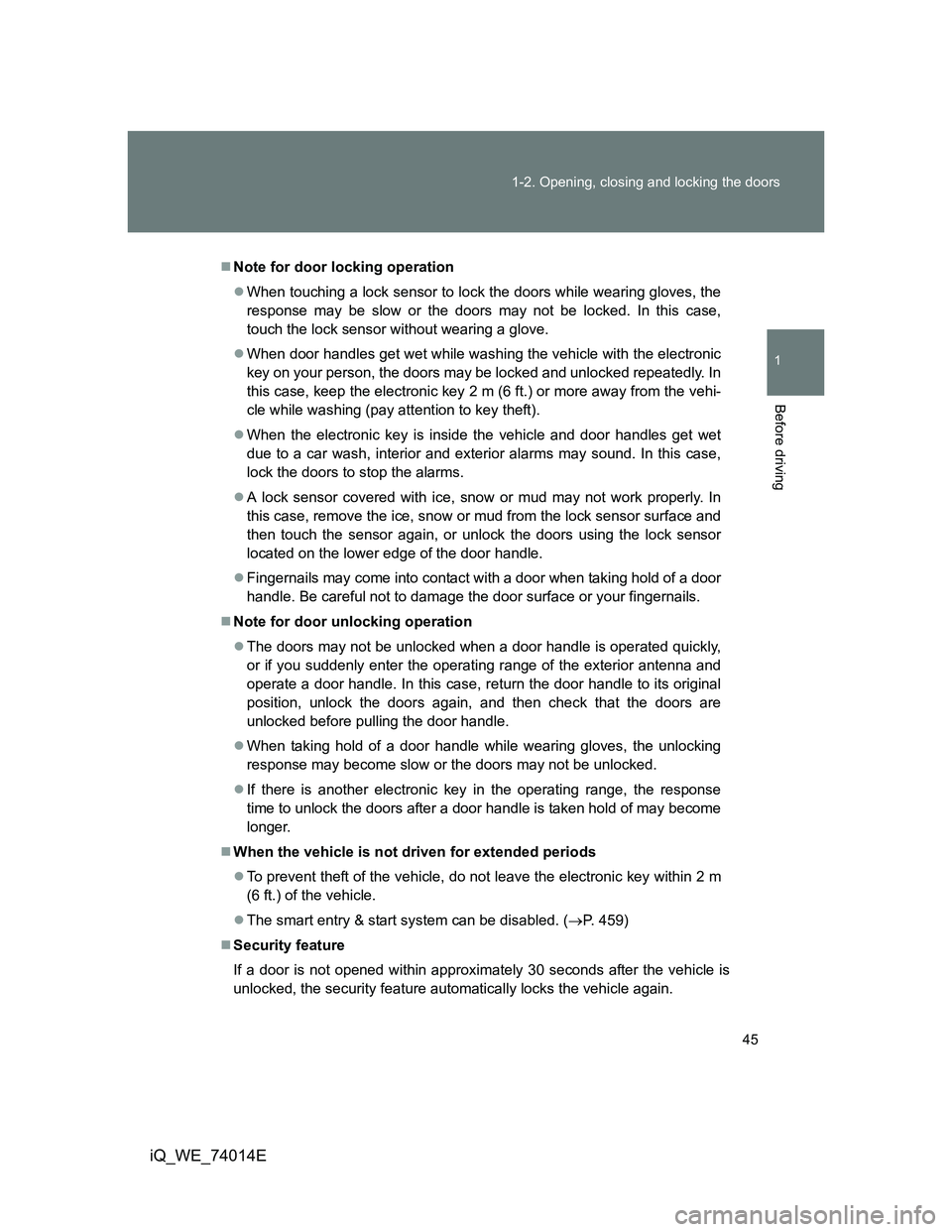
45 1-2. Opening, closing and locking the doors
1
Before driving
iQ_WE_74014E
Note for door locking operation
When touching a lock sensor to lock the doors while wearing gloves, the
response may be slow or the doors may not be locked. In this case,
touch the lock sensor without wearing a glove.
When door handles get wet while washing the vehicle with the electronic
key on your person, the doors may be locked and unlocked repeatedly. In
this case, keep the electronic key 2 m (6 ft.) or more away from the vehi-
cle while washing (pay attention to key theft).
When the electronic key is inside the vehicle and door handles get wet
due to a car wash, interior and exterior alarms may sound. In this case,
lock the doors to stop the alarms.
A lock sensor covered with ice, snow or mud may not work properly. In
this case, remove the ice, snow or mud from the lock sensor surface and
then touch the sensor again, or unlock the doors using the lock sensor
located on the lower edge of the door handle.
Fingernails may come into contact with a door when taking hold of a door
handle. Be careful not to damage the door surface or your fingernails.
Note for door unlocking operation
The doors may not be unlocked when a door handle is operated quickly,
or if you suddenly enter the operating range of the exterior antenna and
operate a door handle. In this case, return the door handle to its original
position, unlock the doors again, and then check that the doors are
unlocked before pulling the door handle.
When taking hold of a door handle while wearing gloves, the unlocking
response may become slow or the doors may not be unlocked.
If there is another electronic key in the operating range, the response
time to unlock the doors after a door handle is taken hold of may become
longer.
When the vehicle is not driven for extended periods
To prevent theft of the vehicle, do not leave the electronic key within 2 m
(6 ft.) of the vehicle.
The smart entry & start system can be disabled. (P. 459)
Security feature
If a door is not opened within approximately 30 seconds after the vehicle is
unlocked, the security feature automatically locks the vehicle again.
Page 93 of 476
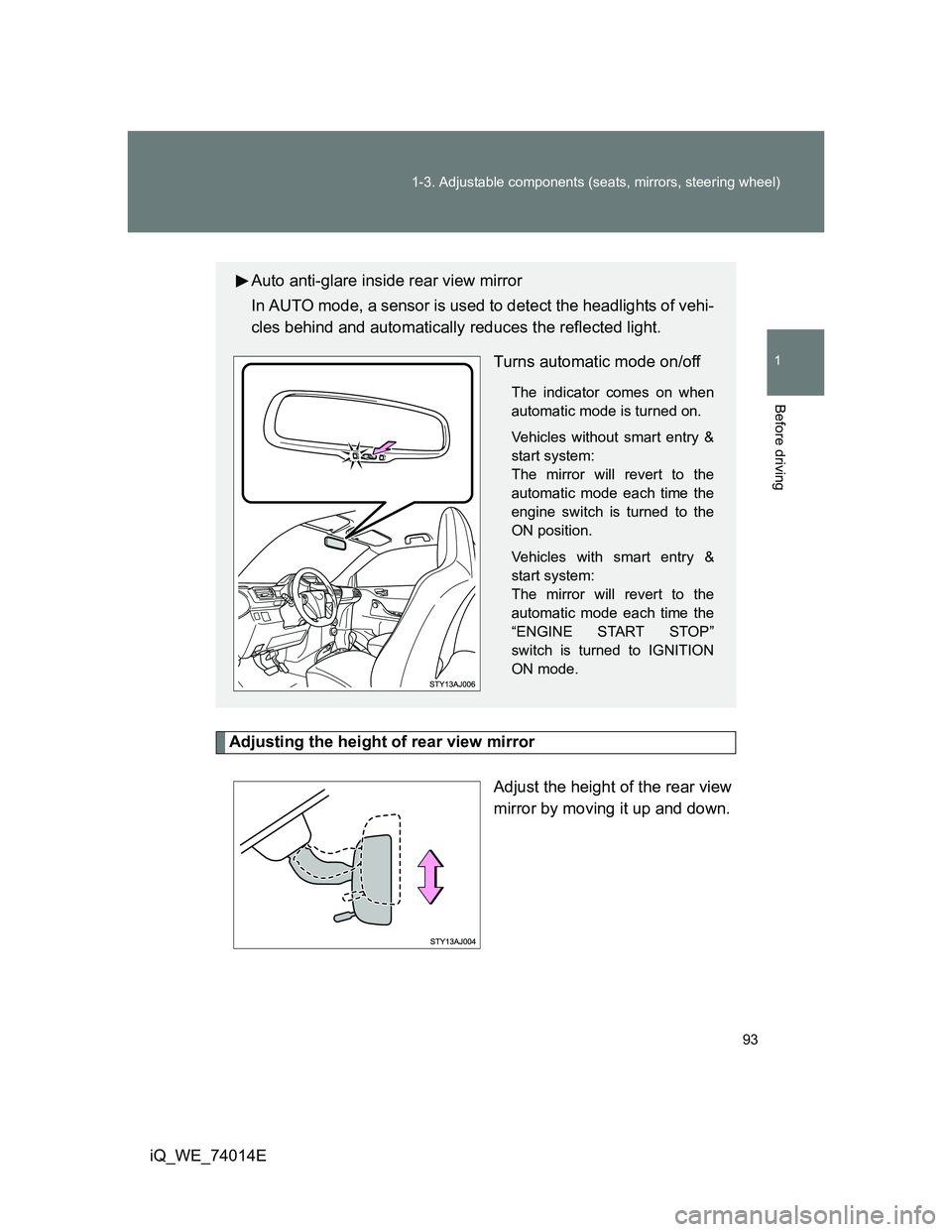
93 1-3. Adjustable components (seats, mirrors, steering wheel)
1
Before driving
iQ_WE_74014E
Adjusting the height of rear view mirror
Adjust the height of the rear view
mirror by moving it up and down.
Auto anti-glare inside rear view mirror
In AUTO mode, a sensor is used to detect the headlights of vehi-
cles behind and automatically reduces the reflected light.
Turns automatic mode on/off
The indicator comes on when
automatic mode is turned on.
Vehicles without smart entry &
start system:
The mirror will revert to the
automatic mode each time the
engine switch is turned to the
ON position.
Vehicles with smart entry &
start system:
The mirror will revert to the
automatic mode each time the
“ENGINE START STOP”
switch is turned to IGNITION
ON mode.
Page 94 of 476
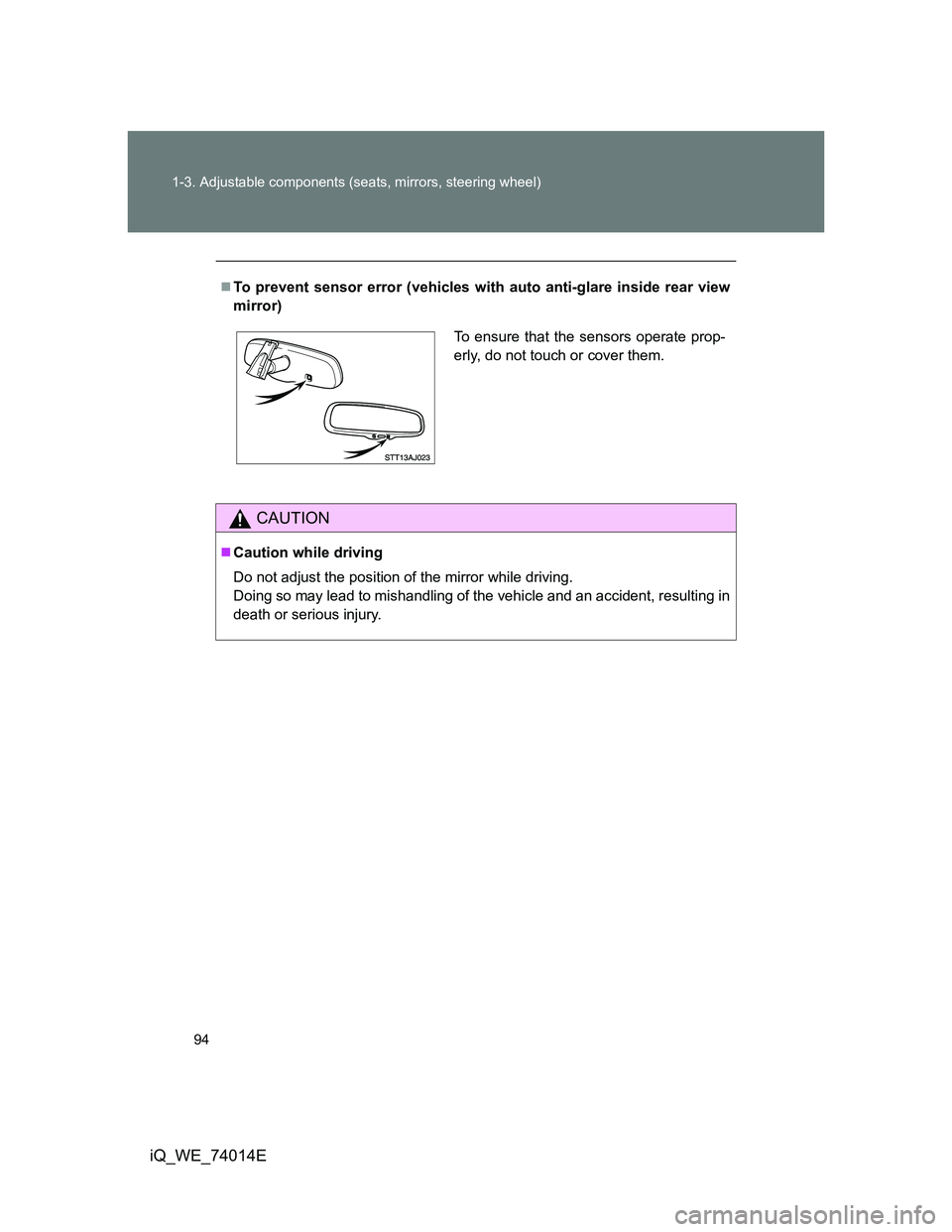
94 1-3. Adjustable components (seats, mirrors, steering wheel)
iQ_WE_74014E
To prevent sensor error (vehicles with auto anti-glare inside rear view
mirror)
CAUTION
Caution while driving
Do not adjust the position of the mirror while driving.
Doing so may lead to mishandling of the vehicle and an accident, resulting in
death or serious injury.
To ensure that the sensors operate prop-
erly, do not touch or cover them.
Page 117 of 476
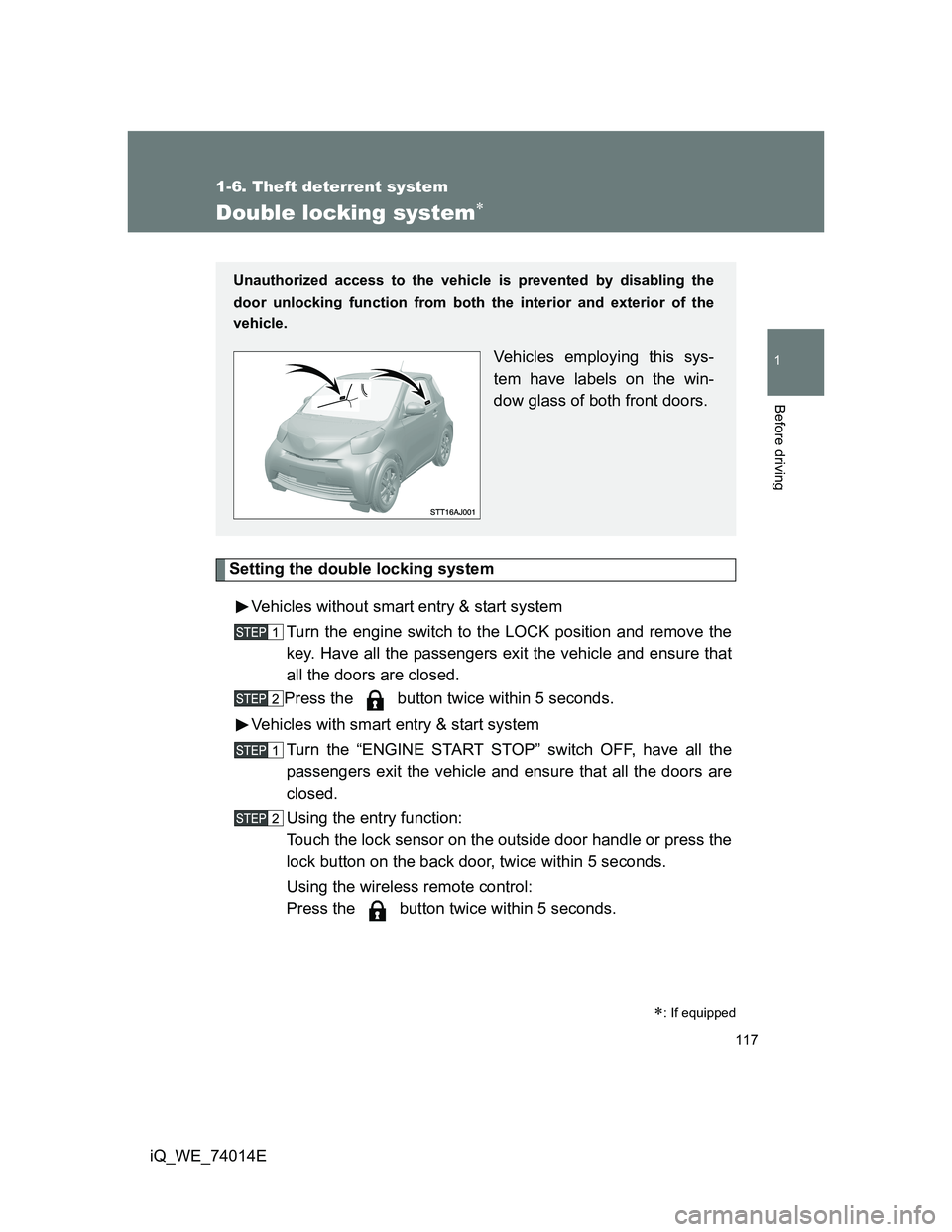
117
1
1-6. Theft deterrent system
Before driving
iQ_WE_74014E
Double locking system
Setting the double locking system
Vehicles without smart entry & start system
Turn the engine switch to the LOCK position and remove the
key. Have all the passengers exit the vehicle and ensure that
all the doors are closed.
Press the button twice within 5 seconds.
Vehicles with smart entry & start system
Turn the “ENGINE START STOP” switch OFF, have all the
passengers exit the vehicle and ensure that all the doors are
closed.
Using the entry function:
Touch the lock sensor on the outside door handle or press the
lock button on the back door, twice within 5 seconds.
Using the wireless remote control:
Press the button twice within 5 seconds.
: If equipped
Unauthorized access to the vehicle is prevented by disabling the
door unlocking function from both the interior and exterior of the
vehicle.
Vehicles employing this sys-
tem have labels on the win-
dow glass of both front doors.
Page 126 of 476
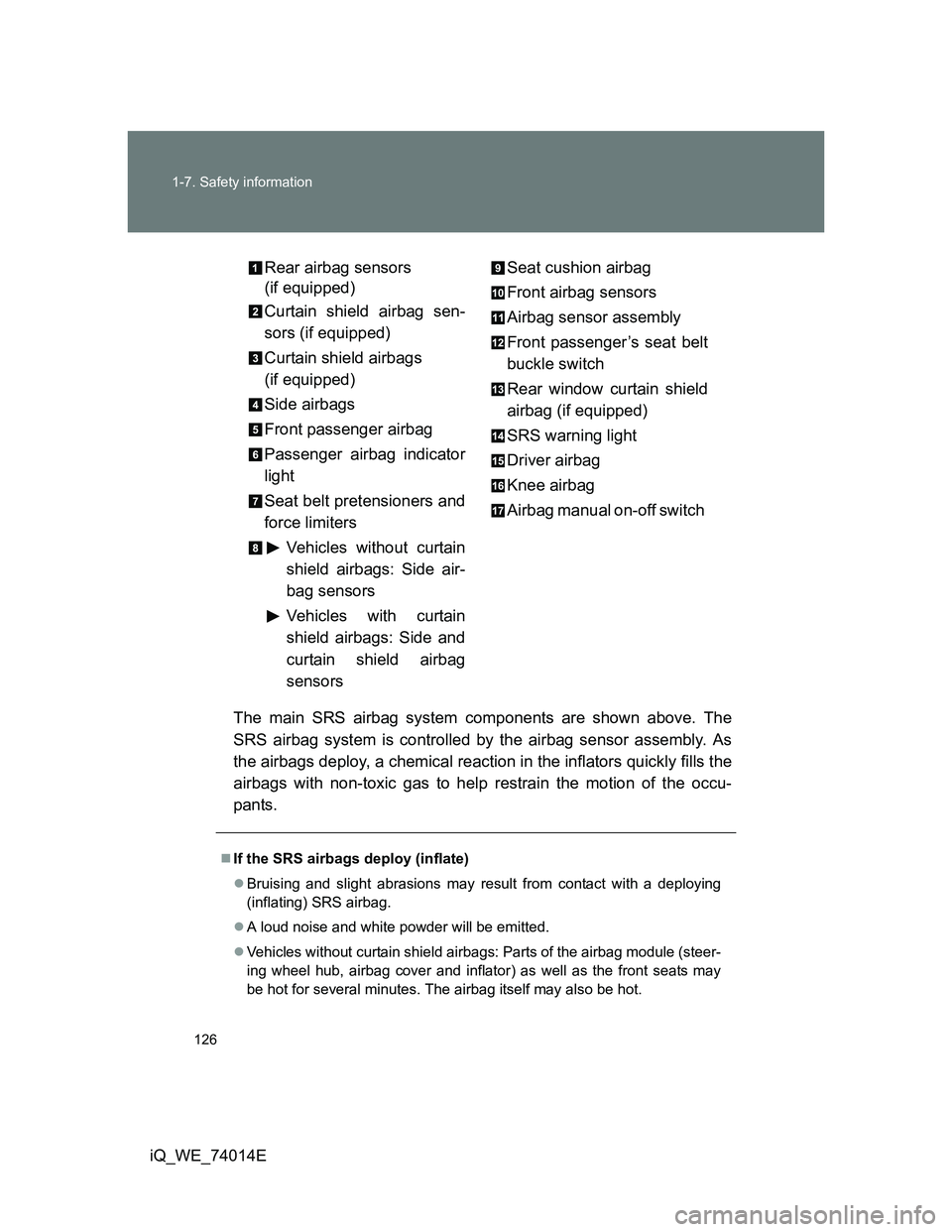
126 1-7. Safety information
iQ_WE_74014EThe main SRS airbag system components are shown above. The
SRS airbag system is controlled by the airbag sensor assembly. As
the airbags deploy, a chemical reaction in the inflators quickly fills the
airbags with non-toxic gas to help restrain the motion of the occu-
pants.
Rear airbag sensors
(if equipped)
Curtain shield airbag sen-
sors (if equipped)
Curtain shield airbags
(if equipped)
Side airbags
Front passenger airbag
Passenger airbag indicator
light
Seat belt pretensioners and
force limiters
Vehicles without curtain
shield airbags: Side air-
bag sensors
Vehicles with curtain
shield airbags: Side and
curtain shield airbag
sensorsSeat cushion airbag
Front airbag sensors
Airbag sensor assembly
Front passenger’s seat belt
buckle switch
Rear window curtain shield
airbag (if equipped)
SRS warning light
Driver airbag
Knee airbag
Airbag manual on-off switch
If the SRS airbags deploy (inflate)
Bruising and slight abrasions may result from contact with a deploying
(inflating) SRS airbag.
A loud noise and white powder will be emitted.
Vehicles without curtain shield airbags: Parts of the airbag module (steer-
ing wheel hub, airbag cover and inflator) as well as the front seats may
be hot for several minutes. The airbag itself may also be hot.
Page 214 of 476
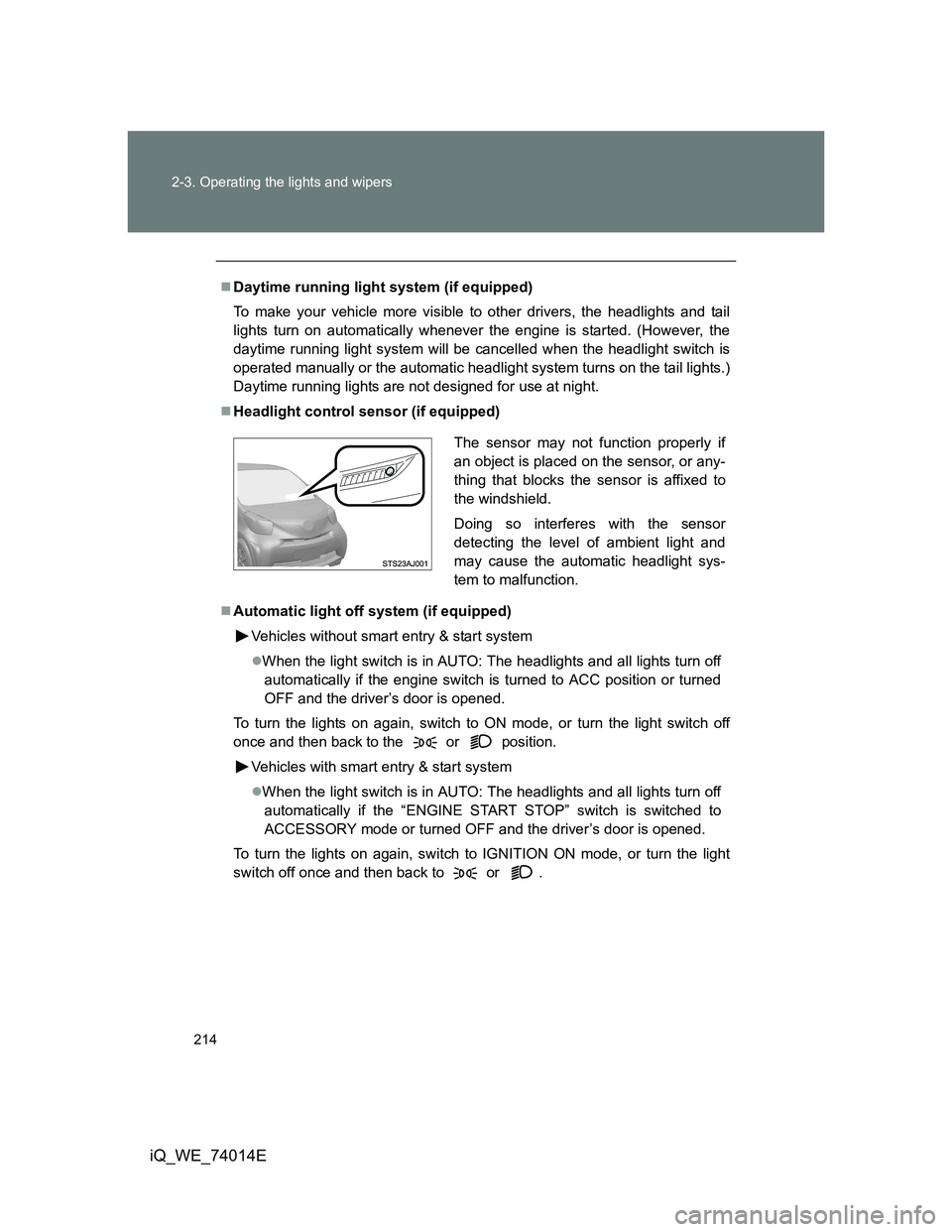
214 2-3. Operating the lights and wipers
iQ_WE_74014E
Daytime running light system (if equipped)
To make your vehicle more visible to other drivers, the headlights and tail
lights turn on automatically whenever the engine is started. (However, the
daytime running light system will be cancelled when the headlight switch is
operated manually or the automatic headlight system turns on the tail lights.)
Daytime running lights are not designed for use at night.
Headlight control sensor (if equipped)
Automatic light off system (if equipped)
Vehicles without smart entry & start system
When the light switch is in
AUTO: The headlights and all lights turn off
automatically if the engine switch is turned to ACC position or turned
OFF and the driver’s door is opened.
To turn the lights on again, switch to ON mode, or turn the light switch off
once and then back to the
or position.
Vehicles with smart entry & start system
When the light switch is in AUTO: The headlights and all lights turn off
automatically if the “ENGINE START STOP” switch is switched to
ACCESSORY mode or turned OFF and the driver’s door is opened.
To turn the lights on again, switch to IGNITION ON mode, or turn the light
switch off once and then back to
or .
The sensor may not function properly if
an object is placed on the sensor, or any-
thing that blocks the sensor is affixed to
the windshield.
Doing so interferes with the sensor
detecting the level of ambient light and
may cause the automatic headlight sys-
tem to malfunction.
Page 215 of 476
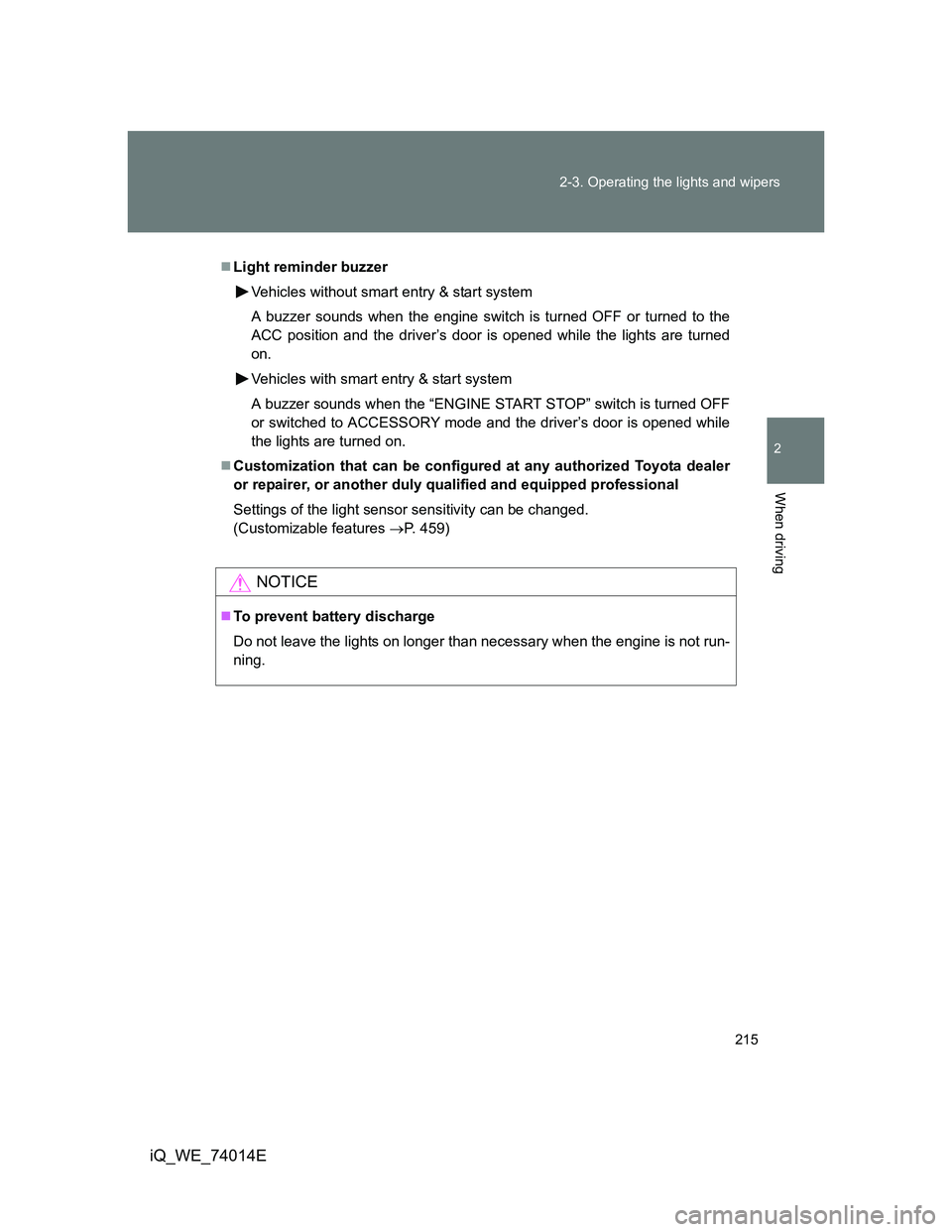
215 2-3. Operating the lights and wipers
2
When driving
iQ_WE_74014E
Light reminder buzzer
Vehicles without smart entry & start system
A buzzer sounds when the engine switch is turned OFF or turned to the
ACC position and the driver’s door is opened while the lights are turned
on.
Vehicles with smart entry & start system
A buzzer sounds when the “ENGINE START STOP” switch is turned OFF
or switched to ACCESSORY mode and the driver’s door is opened while
the lights are turned on.
Customization that can be configured at any authorized Toyota dealer
or repairer, or another duly qualified and equipped professional
Settings of the light sensor sensitivity can be changed.
(Customizable features P. 459)
NOTICE
To prevent battery discharge
Do not leave the lights on longer than necessary when the engine is not run-
ning.
Page 219 of 476
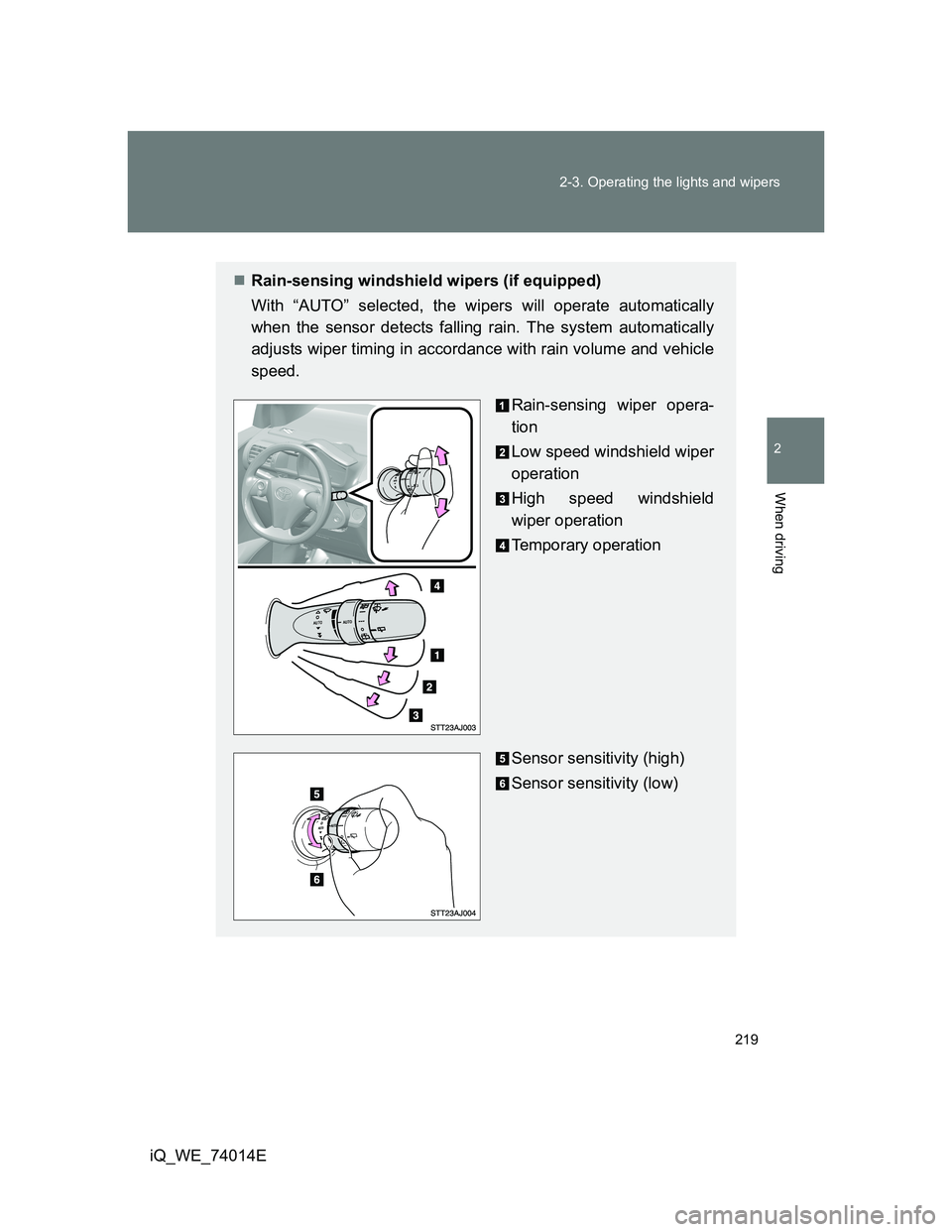
219 2-3. Operating the lights and wipers
2
When driving
iQ_WE_74014E
Rain-sensing windshield wipers (if equipped)
With “AUTO” selected, the wipers will operate automatically
when the sensor detects falling rain. The system automatically
adjusts wiper timing in accordance with rain volume and vehicle
speed.
Rain-sensing wiper opera-
tion
Low speed windshield wiper
operation
High speed windshield
wiper operation
Temporary operation
Sensor sensitivity (high)
Sensor sensitivity (low)